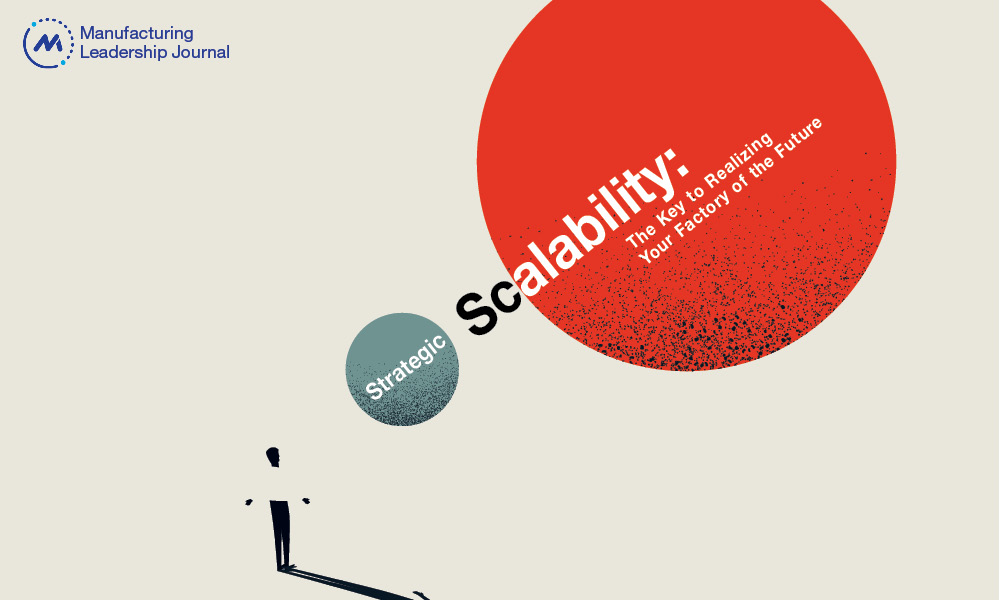Strategic Scalability: The Key to Realizing Your Factory of the Future

Merging new tech with established operations requires a thoughtful approach and a roadmap for sustainable expansion.

TAKEAWAYS:
● A strong technology strategy that addresses the organizational workforce, engineering processes, and effective technology solutions is vital for manufacturing resilience.
● For long-term success, a phased implementation strategy often outperforms rapid adoption of cutting-edge technologies.
● Effective scaling involves swiftly adapting your technology strategy to the unique demands of each operational setting, while establishing a repeatable foundational framework.
In an era characterized by rapid technological evolution and intensifying global competition, manufacturers must not only adapt but strategically reimagine and restructure their manufacturing processes to survive. This journey is unique for every industry sector, individual organization, and manufacturing facility, but often begins with a unified vision for digital transformation and the “Factory of the Future.” This vision is anchored by disruptive technologies such as the Internet of Things (IoT), artificial Intelligence (AI), hyper-automation, and advanced robotics, all aimed at achieving significant gains in efficiency, flexibility, and competitive advantage.
While these new technologies hold the promise of transforming traditional manufacturing into highly agile, customer-centric operations, many manufacturers struggle with their adoption—stifled either by a lack of vision or a failure in execution. These misconceptions or missteps can hinder the progression towards fully digitalized operational environments. The integration of these technologies demands a nuanced, continuous approach underscored by a well-defined strategic framework. In this article, we provide comprehensive guidance on how to formulate, implement, and scale technology strategies that cater to both immediate operational objectives and overarching long-term goals.
Crafting the Strategy: Bridging Today and Tomorrow
To build the factory of the future, organizational leadership must first delineate what the future looks like for their organization. This foresight isn’t about predicting exact technological trends, but rather about understanding where the industry is moving and where an organization’s capabilities lie. The intersection of industry trends and an organization’s core competencies gives birth to its unique technology strategy.

“The intersection of industry trends and an organization’s core competencies gives birth to its unique technology strategy.”
Unfortunately, in their enthusiasm for technology adoption, many manufacturers overlook the foundational step of strategic planning. Failing to plan is essentially planning to fail. This lack of foresight often leads to a fragmented technology landscape, where isolated, high-cost investments yield little impact on overall operations. Conversely, an effective strategy adopts a comprehensive approach that integrates technology, human resources, and operational processes. Central to this strategy are clearly defined objectives—be they cost reduction, quality enhancement, or customer satisfaction—that align with the broader organizational mission and vision.
Developing a coherent strategy includes the following components:
- A detailed assessment of your current manufacturing capabilities, processes, and workflows;
- A robust risk assessment and mitigation plan;
- An assessment of existing skill sets within the organization;
- An analysis of the readiness of the current systems to integrate new technologies; and
- An analysis of the financial implications of the technology roadmap.
Through this rigorous exercise, leaders can identify the most critical technologies that will provide a quick win while serving as a foundation for future scalability. Using this information as a baseline, your technology strategy will evolve from a simple shopping list of the latest technologies into a more comprehensive roadmap that addresses identified gaps and leverages the strengths of existing operations.
Executing the Strategy: A Phased Approach
Navigating the journey from traditional manufacturing processes to the factory of the future is a multidimensional challenge that requires both visionary leadership and grounded pragmatism despite the inclination to adopt cutting-edge technologies in the pursuit of an “overnight overhaul.” This urge to quickly integrate innovative technologies often misleads manufacturers into thinking that speed is a proxy for success. By taking a more systematic and phased approach that compartmentalizes such a massive undertaking, organizations can mitigate risk strategically and allocate resources judiciously, ensuring they maintain operational stability while they improve technological capabilities iteratively. A phased approach also offers the agility and flexibility that are paramount in today’s volatile business environment, without sacrificing the thoroughness and attention to detail that manufacturing firms require. Creating a digital backbone is a prerequisite for success and taking the “start small, scale up” approach drives the ability to make an immediate impact on operations.
According to a 2023 survey conducted by Deloitte, nearly 62 percent of manufacturing firms that opted for an overnight digital overhaul experienced significant operational disruption, compared to just 28 percent of those that implemented a phased approach. While the allure of an expedited transformation is understandable—especially given the competitive edge it promises—these numbers make a compelling case for incremental change. The same Deloitte survey found that 45 percent of companies that opted for rapid transformations incurred unexpected costs that exceeded their initial budget by 20 percent or more.

“Creating a digital backbone is a prerequisite for success and taking the “start small, scale up” approach will enable manufacturers to make an immediate impact on their operations.”
Beyond the statistical backing, a phased approach allows for real-time adjustments and optimization, providing a “safety net” of sorts that can help mitigate unforeseen challenges and expenses and simultaneously align well with the complexities and intricacies of manufacturing. The production process often involves multiple layers of interdependent systems and workflows; a change in one area can have ripple effects across the entire operation. By employing a phased approach, executives can monitor the impact of changes more closely and adjust strategies as needed without disrupting the entire ecosystem. For industry leaders and executives, this approach offers a harmonious blend of innovation, strategic risk management, and astute financial planning. It fosters a smoother transition and higher rates of adoption among employees, creating a rapid—tangible and intangible—time to value.
Ensuring Seamless Execution: The Importance of Integration
Ever-advancing technologies that continue to change the shape of manufacturing are fundamental drivers for reimagining processes, operational efficiencies, and customer satisfaction. Taking small steps to strategically incorporate them into an organization’s operational ecosystem is only the beginning of the journey.
Once a well-articulated strategy is in place, attention must shift to integration, and here the sequence of execution is just as crucial as the technologies selected. While it is tempting to chase the allure of disruptive technologies, indiscriminate adoption often leads to redundant systems, wasted investment, and a complicated, unmanageable technology stack.
System integration is the cornerstone of operational effectiveness in any modern factory setting. A host of variables—including the persistence of legacy systems, data siloing, and a multigenerational workforce—can serve as impediments to the successful enactment of an industrial transformation strategy. The role of human capital and procedural methodologies is non-negotiable in the successful integration of emergent technologies. Multidisciplinary teams, comprising experts in operational technology, data science, and on-the-ground operations, are indispensable for calibrating collective initiatives toward a common engineering objective. The robustness of any digital architecture is fundamentally reliant on three key pillars: 1) seamless technological integration, 2) uniform data governance protocols, and 3) adaptive human resource strategies. Incongruence in any of these domains risks compromising the operational efficacy of the overarching strategy.
Successful integration is not just a catalyst for competitive advantage, it’s a determinant for survival.
In the 2023 Manufacturing Trends Report, Alithya revealed that companies effectively integrating the right technologies with their operational dynamics have experienced a surge in productivity by an astounding 27 percent, and a subsequent reduction in operational costs by nearly 19 percent. What the manufacturing organizations leading the charge in transformation have in common is that they have each cultivated a culture of innovation and integrated these innovations into the very fabric of their operational DNA.
Scaling a Technology Strategy: A Blueprint for Future Readiness
Characterized by fluctuating demand, raw material availability, and geopolitical uncertainties, a manufacturer’s ability to effectively scale a technology strategy is tantamount to achieving operational agility and sustained growth. Scaling is not merely a replication of solutions that have demonstrated value in a small-scale setting; it is an intricately planned endeavor that aligns technology with business objectives, regulatory frameworks, and workforce capabilities. Contrary to popular belief, it does not merely refer to deploying more of the same technology across an enterprise. It involves understanding the contextual intricacies of each operational environment and adapting the foundational strategy to the idiosyncrasies accordingly.

“Your factory of the future vision is not a linear path but a complex, multi-dimensional journey. It requires an integrated approach, focusing equally on technologies, human factors, and processes. ”
What works well in a controlled, small-scale environment may face unexpected challenges when applied across multiple locations or larger operational scales. The foundation of effective scaling is a well-defined technology architecture that adheres to modular design principles and allows components to be added or replaced without disrupting the entire operation. This foundation is essential for project success. This process of using open, yet defined standards ensures that the architecture remains flexible and eases the burden of incorporating new technologies without excessive alterations or a complete overhaul. This symbiosis not only enhances data-driven decision-making but also promotes a culture of continuous innovation, and essentially creates a scalable ecosystem that accommodates growth while maintaining optimal performance levels.
Are You on the Right Path?
Your factory of the future vision is not a linear path but a complex, multidimensional journey. It requires an integrated approach, focusing equally on technologies, human factors, and processes. Successful technology strategies are built on the pillars of organizational alignment, an understanding of your operational ecosystem, and robust governance with a focus on scalability and futureproofing.
Developing transformation strategies are ultimately less about technological adoption and more about transformational amalgamation. It’s not simply adding technology to existing processes but reshaping those processes around new capabilities. For example, AI-driven analytics do not merely speed up data processing; they revolutionize decision-making algorithms. Similarly, advanced robotics are not just about automating tasks, they reimagine the workflow. Thus, in the quest for the factory of the future, it’s crucial to see technology as a dynamic catalyst for organizational evolution.
Manufacturing success is not determined merely by the adoption of cutting-edge technologies, but by a multifaceted approach that synergizes internal capabilities with strategic external partnerships. This synergy allows for the seamless integration of modular solutions into the existing technology infrastructure. Concurrently, it is imperative for executives to foster an organizational ethos that views technology as the critical fulcrum for navigating present challenges and capitalizing on future opportunities. This integrated approach accelerates the return on investment and also augments the firm’s competitive edge in innovation. As we stand on the cusp of a revolution driven by technological capabilities we are only beginning to understand, the existential question for manufacturing leaders is no longer about whether to invest in digital transformation, but rather how to delineate a strategy that judiciously chooses the appropriate technologies and partnerships for transformative and sustainable execution. M
About the authors:

Holly Becker is Director of Commercialization, ATS Applied Tech Systems, LLC